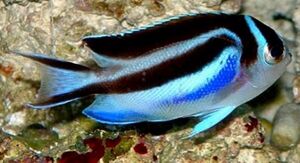Ornate angelfish facts for kids
Quick facts for kids Ornate angelfish |
|
|---|---|
 |
|
| Genicanthus bellus female | |
| Conservation status | |
| Scientific classification |
The Genicanthus bellus, also known as the ornate angelfish or bellus angelfish, is a beautiful fish that lives in the ocean. It's a type of marine angelfish and belongs to the Pomacanthidae family. You can find this fish in the Indo-Pacific region, which covers parts of the Indian and Pacific Oceans.
Contents
What They Look Like
Ornate angelfish are special because the males and females look very different. This is called being sexually dichromatic.
Female and Young Angelfish
Female and young angelfish usually have a grey or bluish body. They have wide black stripes and a blue line along their lower sides. One black stripe goes from the top of their head, through their eye, and stops below it. Another black stripe starts behind the first one, makes a corner near the top fin, and runs along its base. A third stripe goes diagonally down towards the tail fin. The last black stripe runs along the top edge of the upper part of the top fin. These black stripes often have white or light blue edges. Females also have two shiny white dots on their black upper lips.
Male Angelfish
Male angelfish are pale blue or grey. They have golden stripes that run horizontally along their sides. One stripe is in the middle of their body, and another is along their lower back. The fins near their chest and on their back are the same color as these stripes. Their tail fins are often clear with orange spots. They also have bright blue tails that look like they have long, flowing parts. Their lips are bright blue too.
Size and Fins
This angelfish can grow up to about 18 centimeters (7 inches) long. It has 15 spines and 15 or 16 soft rays in its top fin. The fin on its belly has 3 spines and 16 or 17 soft rays.
Where They Live
The ornate angelfish lives in a wide area of the western Pacific Ocean and eastern Indian Ocean. However, it's not found everywhere in these areas; its homes are often in specific spots.
You can find them near places like Tahiti, Guam, Palau, and the Cook Islands in the Pacific. They also live near the Philippines, southern Japan, and Indonesia. In Australian waters, they are found around the Cocos (Keeling) Islands and Christmas Island in the Indian Ocean. They are also seen at Holmes Reef in the Coral Sea. Because they prefer to live in deeper waters, scientists might not have found all the places where they live yet.
Their Daily Life
Ornate angelfish live in deep parts of the ocean, usually between 25 and 100 meters (82 to 328 feet) deep. They like deep reefs, especially where strong currents flow.
Social Life
These fish are very social and live together in groups called schools. Within these schools, they form smaller groups called harems, which usually have 3 to 7 fish.
Reproduction and Life Cycle
All angelfish are born female. This means they are "protogynous hermaphrodites." When they are young adults, they are female. But if there isn't a male around, the strongest female can change into a male. This amazing change can happen in as little as two weeks!
What They Eat
Ornate angelfish mostly eat tiny floating creatures called plankton. They gather in groups in the middle of the water to feed on these. They also eat small animals that live on the ocean floor, like worms and tiny moss animals. Sometimes, they eat algae too.
How They Were Named
The ornate angelfish was first officially described in 1979 by an American fish expert named John Ernest Randall. He found the first one near Tahiti. The name bellus means "beautiful" in Latin, which is a perfect name for this lovely fish! This angelfish is known to sometimes breed with another type of angelfish called the blackstriped angelfish.
Ornate Angelfish as Pets
It's quite rare to find the ornate angelfish in pet stores that sell fish for aquariums. This is because they live in very deep waters, making them hard to catch. When they are collected, some fish might not survive the journey. However, if they are healthy and get used to their new home, they can be strong and hardy pets.


